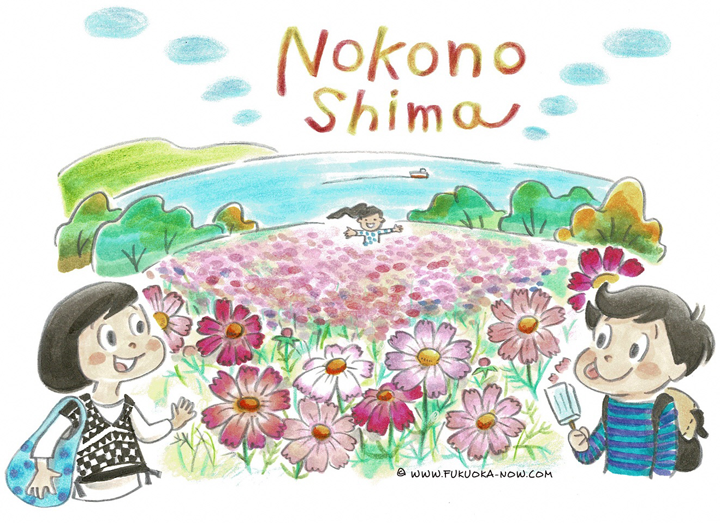Hakata Culture vol.175
Nokonoshima in the Fall: An Island of Beautiful Cosmos

Nokonoshima is known for the many different flowers that bloom there throughout the year. In past articles, we have introduced the flowers that bloom from spring to early summer, like nanohana (rapeseed), but this time we would like to shine the spotlight on another mainstay of Nokonoshima: its cosmos. At Nokonoshima Island Park in the northern part of the island, about 500,000 cosmos flowers burst into bloom every year when the season comes around. With the blue sea and sky as a backdrop, the sight of the cosmos in varying shades of pink and white swaying in the wind is breathtaking.
The early cosmos start blooming in early October, and the late cosmos bloom until early November, so you can enjoy them for a relatively long time. Seasonal flowers are planted throughout the park, so you can enjoy dahlias and salvias along with the cosmos. After the cosmos season ends, you can see the vibrant fall foliage, and winter flowers like sasanqua and camellia continue to bloom. Later, in January and February, you can enjoy the scenery of Japanese narcissus blooming all over the place.
Nokonoshima is also home to the Nokonoshima Museum, which has a collection of materials associated with Nanmei and Shoyo Kamei, a father-and-son duo who were featured in a previous article. The museum has a wealth of valuable materials related to the surrounding sea, and since it is located on a hillside, it also affords a panoramic view of Hakata Bay. In one corner of the garden, you can view the remains of an old Noko ware kiln, which used to serve as an official kiln for the Fukuoka Domain. The kiln only operated for 20 years in the middle of the Edo period (late 18th century), and the pieces it produced are known as "Phantom Nokoyaki" because so few of them remain.
Shirahige Shrine, located on the southern end of the island, enshrines the guardian deity of Nokonoshima. It is said to have been founded in the Nara period (710-794), and it originally enshrined a huge stone that still exists near the top of Mt. Noko. The imposing main hall and worship hall were built in the Edo period and are designated as tangible cultural properties of Fukuoka City. The annual Okunchi festival held on October 9 still retains the atmosphere of years gone past, and it has been designated as a folk cultural property of Fukuoka City.
コスモスが美しい秋の能古島
1年を通じて花の名所として知られる能古島。以前、菜の花に代表される春から初夏にかけての花を紹介しましたが、今回はもうひとつの代表的な花であるコスモスについて紹介したいと思います。島北部の「のこのしまアイランドパーク」では、季節になると約50万本のコスモスが咲き誇ります。青い海と空を背景に、濃淡のピンクや白のコスモスが風に揺れている様子は圧巻です。
早咲きのコスモスは10月上旬から咲き始め、遅咲きのコスモスは11月上旬まで咲いているので、比較的長く楽しめるのも魅力のひとつ。園内のいたるところに季節の花が植栽されていて、コスモスと一緒にダリアやサルビアも鑑賞でき、コスモスの時期が過ぎても紅葉、サザンカ、ツバキなど冬の花が続きます。1~2月にかけては日本水仙が一面に咲いている風景が楽しめます。
能古島には、以前紹介した亀井南冥・昭陽父子の資料を集めた能古博物館があります。博多の海にまつわる貴重な資料も多く、丘の中腹にあるので博多湾が一望できます。庭園の一角には福岡藩の藩窯だった能古焼古窯跡がそのまま残されています。江戸時代中期(18世紀後半)にわずか20年間だけ操業し、完成品がほとんど残されていないためì幻の能古焼îとも呼ばれています。
さらに島南部にある白鬚神社は能古島の産土神。奈良時代に創建したと伝わり、もともとは能古山頂に近い場所に現存する巨石を祀っていたとされています。堂々とした本殿や拝殿は江戸時代に造られたもので市の有形文化財となっています。また10月9日に行われる例祭おくんちは、古い時代の行事の様子を今も残していて市の民俗文化財に指定されています。

